It Used to Cost $50,000. Now Almost Anyone Can Try It Out. Unfortunately, I Loved It.
Surf travel—the hunt for a perfect wave—is a search for the sublime, a pursuit of fleeting transcendence, a journey into the fabled wilderness. The journey I took on a late February evening was no different. When I left my apartment in Brooklyn after work, backpack stuffed with wax, fins, and board shorts and my board tucked beneath my arm, it was bitterly cold, the temperature in the low 40s, raining and on the verge of sleeting. The wind was south-southeast, 17 mph, gusts at 24 onshore. The Long Branch buoys were reading 5.1 feet at 11 seconds, east-southeast. It had been dark for hours.
These were abysmal conditions for surfing, as any semiexperienced East Coast surfer would attest. Luckily, the Skudin Surf wave pool was immune to such calculations.
The water would be an amniotic 80-something degrees. The waves would be 2 or so feet high, pumped out mechanically in 30-second intervals. Beneath the climate-controlled dome, there would be no wind. I was going surfing in a mall.
Millennials prefer to spend money on experiences rather than things, inveighed the Great Brand Consultant of the 2010s, and so the American Dream mall in East Rutherford, New Jersey—in a radical campaign to save traditional retail, in the throes of internet-fueled demise—went gargantuan on experience. The result is the country’s second-largest mall, a flagship shopping destination overfull with superlative flagship attractions, including, by its own measure, three record-setting roller coasters (steepest plunge, longest free-spinning coaster, and tallest indoor-spinning-drop tower); America’s largest indoor snow arena and ski slope; and North America’s largest indoor water park. And, tucked right in the water park’s nucleus, the country’s largest indoor surfing wave pool. To call it a mall, really, is to undersell it. This destination, without question, is a complex.
To get there from the city, I boarded a northbound C train. Easy enough to find a seat going that direction, that time of night. I propped the board up against the seat and rode uneventfully to Penn Station. There, I joined the rush of commuters, also toting valuables under their arms, to New Jersey. (The board went down the aisle less smoothly on the NJ transit train, plunking off one headrest after another in front of a bewildered work crowd.) Off at Secaucus, just one stop later, I wedged my board across the back seat of the sedan of my photographer and colleague Aymann, and he drove us the last leg.
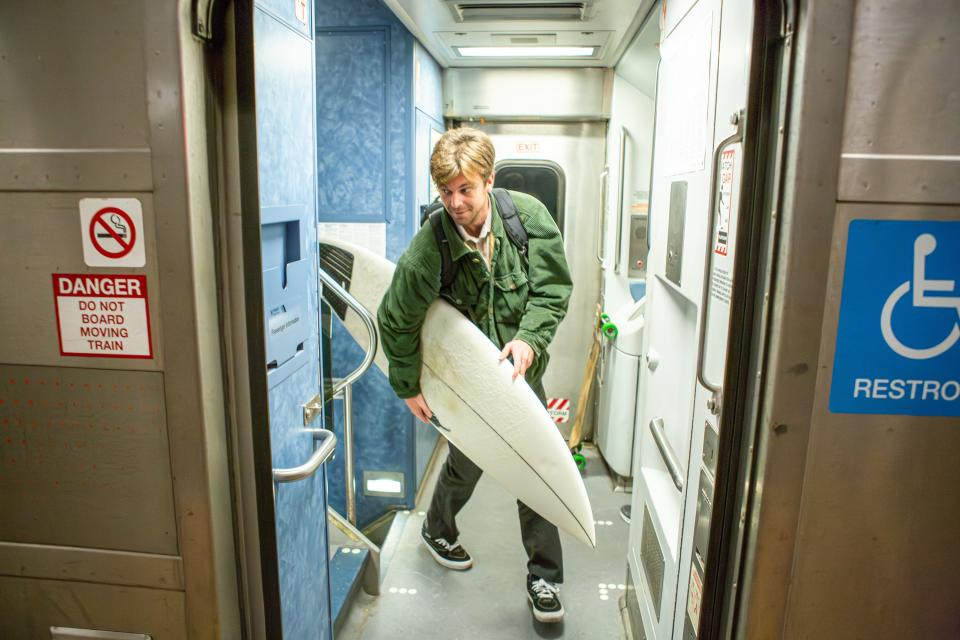
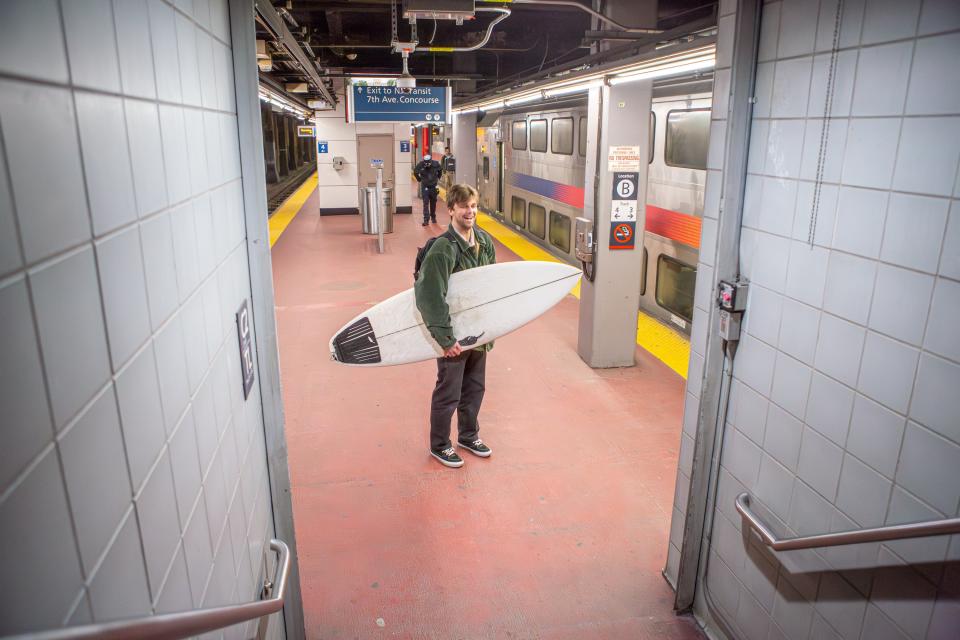
The Dream lacks for nothing, save for convenient public transit options to get there and back on weekday nights. (There are three helipads and zero train stops.) For a surf destination, this challenge arguably adds to the pool’s allure—easy access begets overcrowding, though open sessions were capped at 20 people anyway.
Still, a few minutes past the 9:15 p.m. check-in for the 10 p.m. session, the fluorescent escalator bank in Parking Lot B was teeming with surfboards, beachwear, anticipation. A dozen or so fellow surfers stood huddled with boards large and small, foam and fiberglass. The Dream provides rental boards, but as this was an advanced group, few were taking their chances with some off-the-rack craft. I sized up the crew; some groms, some grizzled old heads.
Our leader was Torpedo. (He insisted that his name was Torpedo.) He wore a hat that said “Torpedo.” He wore board shorts and slip-on shoes. He reminded us, had we not already, to sign those waivers.
Yes, this was going to be silly and excessive, and probably it would kind of suck. (I grew up surfing … outdoors.) But there was also sort of a lot riding on these mall waves. There were stakes. Stakes for the brick-and-mortar retail sector, ravaged by e-commerce; stakes for the surf industry, recently consolidated and pillaged by private equity; stakes for youth culture, which once played a big role in surfing and malls, and whose members—the youth—weren’t doing so well themselves of late; stakes for subculture generally, newly professionalized and optimized; stakes for journalism, even. The two great exponents of New Journalism, one of 20th-century America’s defining written forms, found inspiration exactly here: Joan Didion’s Esquire debut was an ode to the shopping center. Tom Wolfe’s 1968 breakout hit, “The Pump House Gang,” for which one of his essay collections was named, was about the San Diego surf scene. Journalism isn’t doing too well either. Everyone was in need of some salvation.
“The mall is massive,” warned Torpedo. “If you take a wrong turn, you’ll end up in the wrong city.” With that, we got on the escalator, ready to ride.
In the ocean, waves come from the wind, usually from storms out at sea. Some blustery tempest pushes the water in all directions, and off it goes, extending sometimes hundreds of miles—that energy looking to exhaust itself or else crash, usually into a shoreline. Whether the wind comes from, say, a hurricane or a nor’easter is reflected in wave size, shape, and frequency. But storms are not orderly or predictable. Sometimes there is too much wind or its direction is wrong; most of the time there is not enough of it, and thus no waves at all. Ocean surfing is devilishly unstandardized. No two waves—when you are, again, lucky enough to have waves—are the same. That problem has been solved for with the invention of mechanized surf.
There was still a trick, though, to accessing the wave at the American Dream. Our crew schlepped, boards propped atop heads and under arms, past an empty Pandora, past an empty Sunglass Hut, past an empty American Eagle, and near a MrBeast Burger restaurant, the latter establishment currently ensnared in a lawsuit filed by Beast himself over a product described in court filings as “inedible.” We followed illuminated directions toward the DreamWorks Water Park, the Nickelodeon Universe, and the Angry Birds Mini Golf course. A sign that marked a detour to Toys R Us was not lit, though it was unclear if that was an electrical issue or a reflection on the state of the retailer’s bankruptcy.
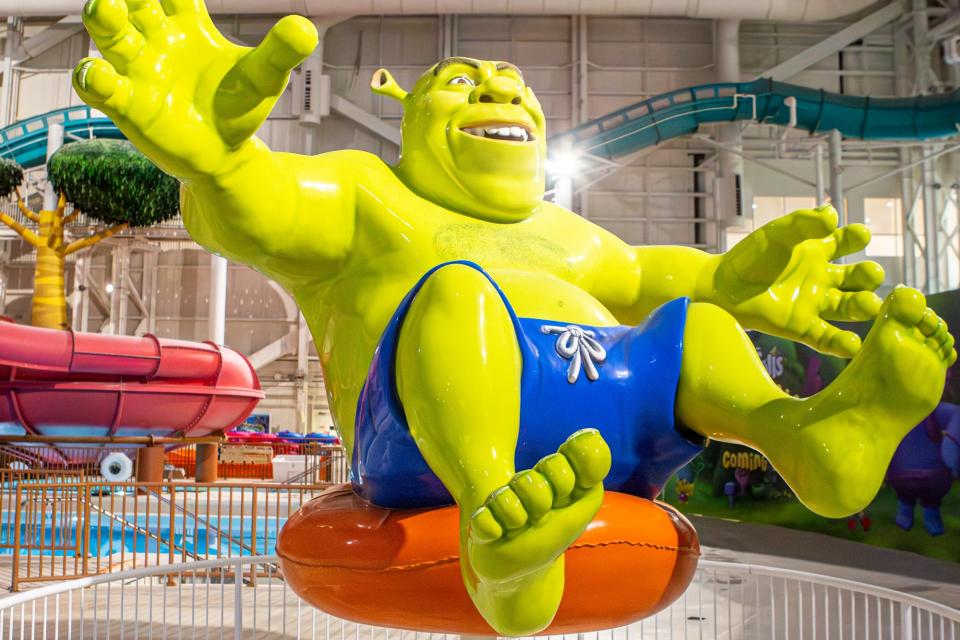
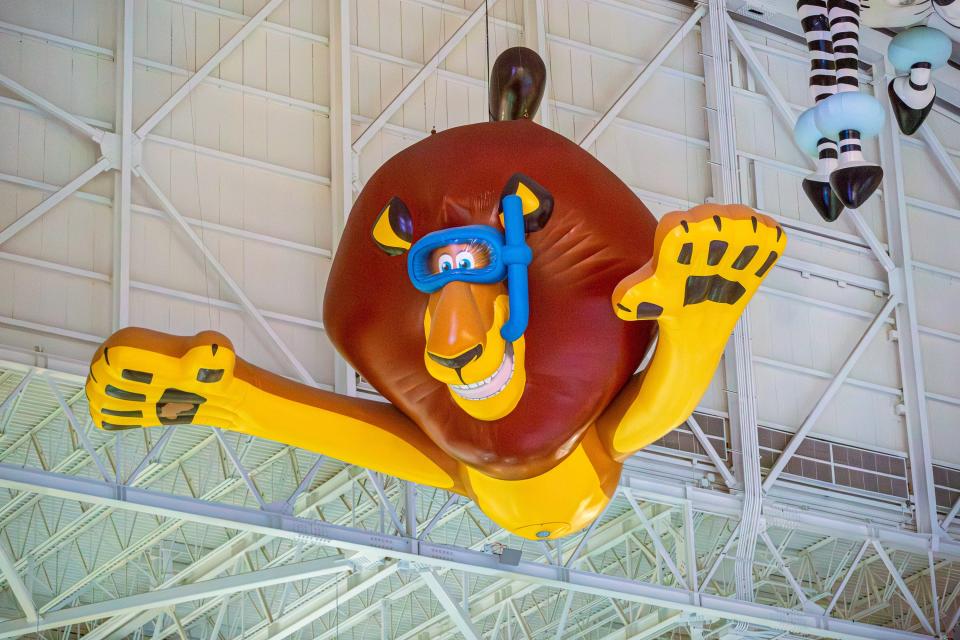
From underneath prodigious plastic effigies of Shrek, Kung Fu Panda, and a bunch of cartoon characters from the movie Madagascar—all suspended from the ceiling and bedecked in swimwear—we entered the pool area. There, in the nest of brightly colored slides, was our electric-blue oasis. Tears welled up, not because of the sheer beauty of this artificial creation but because of the incredible quantity of airborne chlorine.
Torpedo delivered us to a guy named Mike, who instructed us about the wave’s peculiarities. The wave, effectively, is projected out of the wall from underneath another large plastic Shrek. Stay as close as you can to the wall, we were told. There will be a pulse of water, which is not the wave; the wave will shoot out a few seconds after. Paddle more than you would in the ocean—it’s harder to get into the wave than you might think.
The beginners, we were told, would be relegated to the white water in the shallow end. Kooks, I might have muttered, under my breath. Advanced surfers would be out at the wall, riding the unbroken wave. There was a queueing system, we were told. The wave has both a left and a right, so paddle to the side of the direction you prefer and float in line. We would have one hour to surf the “A-frame”; in Hour 2, it would be cranked up to “Gotham peak,” which, Mike said, was “a little more punchy.”
“What?” asked one of the surfers. Despite the standardization of the mall waves, surfing’s terminological system remains somewhat mongrel, very regional, and sort of made-up.
“More punchy,” Mike restated, incredulous and no doubt scanning his unwritten thesaurus for a more general synonym. More walled, perhaps, or pitchier, more top to bottom, I thought. In San Diego, where I grew up surfing, we might just have said it had more push. “Uhh,” Mike grumbled, “like, more oomph.”
Mike warned of the “concrete reef,” which, as commentary on the state of the world’s marine ecosystems, seemed trenchant—the pool’s concrete was indeed the exact hue of bleached coral—but was otherwise confusing. Nothing was reeflike about the flat bottom of the pool, as far as I could tell. And there certainly were no colorful fish swimming around.
A few minutes later, we hit the water, paddling out. Actually, I just walked. The water didn’t get deeper than a few feet until I was already in the floating queue. The Offspring started blaring over the speakers.
The story of the Dream complex begins in 1996, when a developer called the Mills Corp proposed dropping a 2-million-square-foot entertainment center on top of some ecologically precious wetlands in Carlstadt, New Jersey. Mills didn’t get its fragile habitat of choice, but a few years later, the developer won a bid from the state to raise up that same basic structure in the nearby Meadowlands. It planned to name the complex Xanadu, after the estate of the newspaper baron in the movie Citizen Kane.
Almost immediately, the Securities and Exchange Commission began investigating Mills for accounting fraud; the firm soon announced that it wouldn’t be able to finance Xanadu after all.
From that moment on, the mall evinced an almost providential penchant for collision with the Great Forces of History and Nature. Construction on the project started in 2004, haltingly. It idled. It started again. Then it began to change hands. It found a willing lender in a group called—yes—Xanadu Mezz Holdings to plug a widening funding hole. But Xanadu Mezz was a subsidiary of Lehman Brothers, which went down spectacularly in the 2008 financial crisis, and the lender predictably defaulted after Lehman’s bankruptcy.
In 2011, well before the mall even opened, the roof over Big Snow, its indoor ski slope, caved in beneath an excess of (outdoor) snow, a defiant unification. Following that, the project idled for years. New Jersey Gov. Chris Christie called it “by far the ugliest damn building in New Jersey and maybe America” and, soon after, pledged $200 million in public funding to help pay for its completion. The complex got a rebrand, then, as the American Dream.
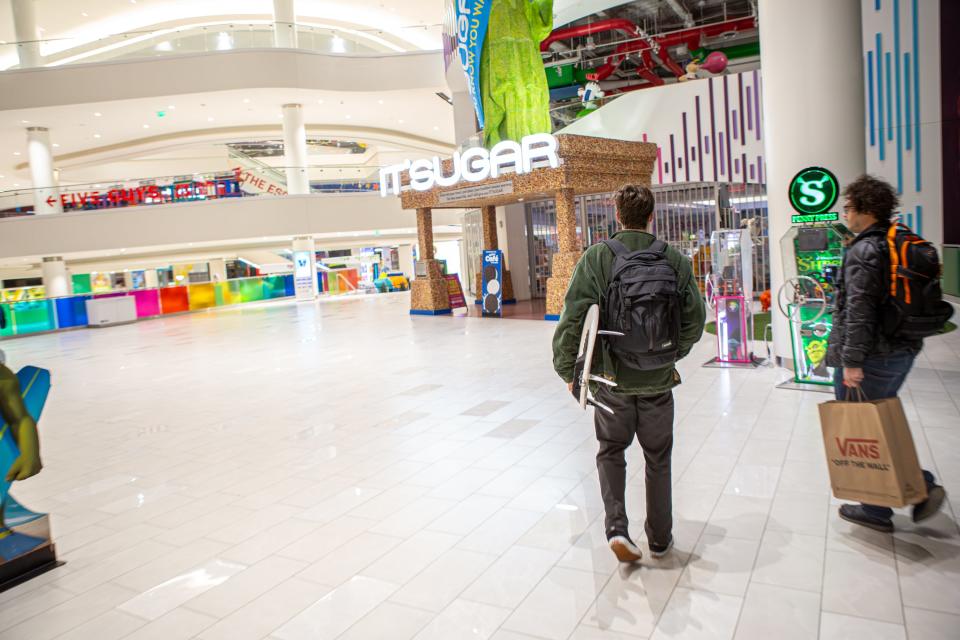
$5 billion later, it was unveiled as a 3.5-million-square-foot extravaganza, with 70 percent of its surface area devoted to entertainment facilities. The Dream partially opened its doors in October 2019 and was slated to roll out the rest of its grand opening through March 2020, a 100-day unveiling that started 100 days before COVID shuttered basically every indoor space in the country. Of course, by that time too, millennials—who were being catered to with all that experience—had been surpassed by the cripplingly online Gen Z as the most sought-after consumer generation, which perhaps informed the decision to top it all off with a bunch of digital IP made incarnate. (The Legoland Discovery Center, the Sea Life Aquarium, and a Coca-Cola–themed restaurant are apparently still to come.)
That’s not an exhaustive list of the Dream’s problems. Last year, the Bergen Record found that 82 lawsuits against the mall have been brought in New Jersey since 2018. In 2021 Coresight Research estimated that 25 percent of America’s 1,000 remaining malls would close over the next three to five years. In 2022 the Dream announced that its losses totaled $245 million.
None of that is very good. But so far the Dream lives on.
At any new surf spot, there are two classes of surfers to be feared, respected, or otherwise accommodated: locals and groms, a term for young surfers. They set the terms; they run the lineup—locals because they’re territorial and long-tenured and they know what’s going on, and groms because they have no compunction about heckling and are prone to mischief. There are exceptions to this rule, but generally speaking, this is how the hierarchy is stacked, a refutation of the idea of meritocracy or class stratification. You can’t buy or even really perform your way to the top of a lineup. Locals in particular make up the body tasked with regulating who surfs when—if self-governance collapses, they enforce the order. They can call you into a wave or call you off it. They have priority. There’s an etiquette.
All of that was changed in the pool. We all paid the same $250—plus tax, plus 6 percent service fee—to be here. Still, there were locals. “We’ve got a good group of regulars,” Lucas, who had been working at the pool nine months, told me, standing waist-deep in the shallow end with some of the beginners. “There’s a group of intermediate guys, and there’s a group of advanced guys who rip. A lot of dentists, actually.” I asked him how this current crew stacked up. Very solid, he assured me.
Most people I surfed with that night had been there only once, though one guy told me he’d surfed the morning session that day, at 8, and returned for the late sesh. Denis, a 31-year-old Frenchman, told me he’d been there 10 times at least. He wasn’t a dentist; he worked in finance.
I tried to be deferential. Once, Denis started paddling as though he were going to cut the line, real local behavior: I looked on with glee. But he was just changing sides, from the left to the right, and retook his place, last in line.
After that, it became clear that Denis wasn’t regulating the lineup. That task was relegated to a woman named Lani, one of the pool’s employees, who was bobbing in the water in a pink life vest, calling us into waves. “One, two, and paddle,” she incanted. “One, two, and paddle.”
I got my first few waves, with discomfort. Here’s how it goes in the American Dream pool: You paddle yourself as close to the wall as possible, so close you can’t see Shrek, then turn your back to it, an aquatic parallel park job, choreography made critical by the surfer an arm’s length from you doing the same thing. The first surge of water, which sucks down, is like a small rapid. More than once it pulled me entirely underwater. You wait, there are two counts from Lani, and you paddle. You never see the wave coming, because it doesn’t really stand up until the time you are standing up.
It wasn’t so foreign; after 20 years of surfing, I could hack it. I got up on one surge of water, crouched in the hopes of gaining some speed, and attempted a turn. On subsequent waves, I did that turn again, and again, and again. I learned quickly. Travel to the bottom of the wave and you would get left behind, marooned in the shallows of the pool. Stay too high and you’d float weakly out the back. Midface, though, you could generate enough force to pull off one maneuver: a snap, a turn, really any change of direction. That’s all there was time for. You had to rush, each wave a wind sprint to the finish. I wished then that I were 30 pounds lighter for a little more buoyancy. I commiserated with Denis about how to wring the most possible action out of the wave, but he was appropriately laconic for a local. If he had insider knowledge, he wasn’t giving it out for nothing to a first-timer like me.
In the first hour, I hit the wall repeatedly. I hit the concrete reef repeatedly, with my body, with my board. One of my friends, a longtime surfer from New Jersey, warned me that this might happen. He had been to the Dream before and, on his first attempt, had fallen face first and broken his cheekbone.
Almost a decade ago, one artificial wave swept through surfing and changed it forever. The Slater wave pool, as it came to be known—pioneered, owned, and branded by Kelly Slater, the uncontested best surfer of all time—delivered privatized perfection on demand in an arid patch of Central California farmland. The wave was, sort of inarguably, a sea change. William Finnegan, writing in the New Yorker, summed it up succinctly: “The sport now has only two eras, Before Kelly’s Wave and After.” Gone was the ceaseless search for the fleeting sublime; now it could be available on demand. It seemed to be a vision of the future—though what that meant was unclear. Would wave pools “democratize surfing,” pondered the New Yorker?
Not exactly. Slater’s wave turned out to be the future of C-suite retreats and birthday parties for angel investors; it cost $50,000 to rent the pool for a day. It also turned out to be the future of authoritarian petrostates in the Middle East looking to soften their international image and diversify their touristic range; the second Slater wave was erected in the United Arab Emirates, one of the world’s most water-scarce nations. The exorbitant pricing and public inaccessibility meant that “democratizing” was totally out of the picture. Most surfers, including me, have only ever seen this wave in videos online.
Still, that first artificial wave did make painfully clear that professional surfing had entered a new epoch, one exemplified by Slater himself. Until pretty recently, surfing existed uncomfortably as a sport, given that there were no goals or mile times by which one might score or improve, and purists have long hated the arbitrary nature of surf contests. It fit more uncomfortably still as a profession. But in part because the winningest competitive surfer of all time, Slater, is also a serial entrepreneur and compulsive businessman, surfing slowly started to doff its countercultural ethos. It got more mainstream attention. It got lobbyists. It got into the Olympics.
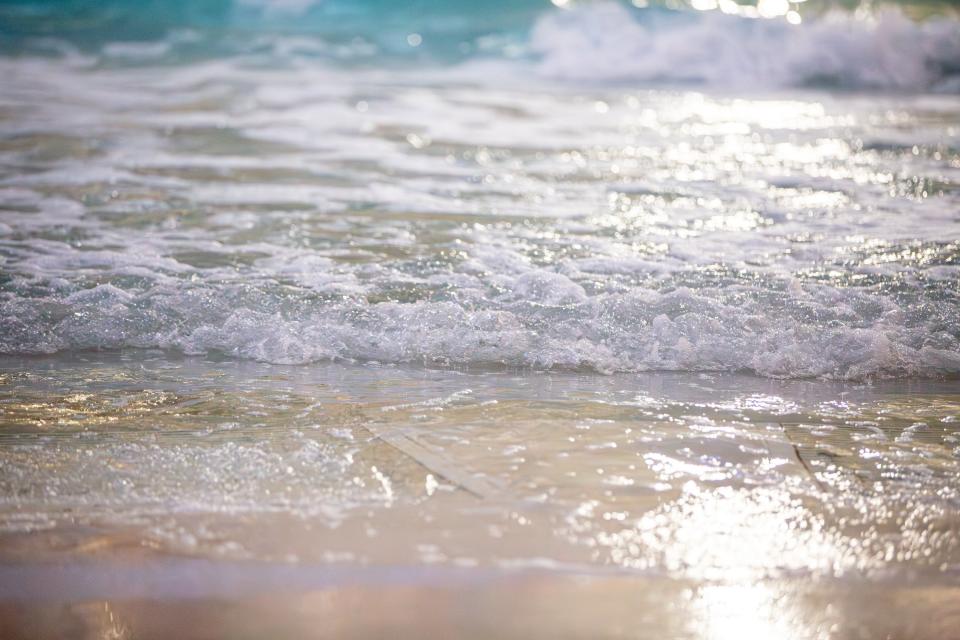
And although surfing never fostered a clear radical, coherent anticapitalist ethic—it was beloved in Hollywood in the 1950s and ’60s, and as Tom Wolfe noted, the New York business world has long been delighted with surfing’s marketing potential when it comes to selling shorts and T-shirts—the sport’s countercultural bona fides were not nothing. Prior to Slater, its most famous American was arguably Miki Dora, who got pinched by the FBI for credit card fraud and probation violations and copped multiple tours in the federal pen.
For a while, surfing sat at an uneasy angle to some of its more capitalist intrusions. But over a handful of years in the 2010s, the asset management firm Oaktree Capital bought up many of the major surf brands started by surfers, before flipping them to Authentic Brands Group, a multibillion-dollar licensing and holding firm owned largely by two private equity firms. The result, as surf magazine Stab put it in a 2019 headline, is that “Almost the Entirety of Surfing Is Now Owned and Operated by Non-Surfers.” Those brands once paid pro surfers lavishly to wear their clothes or spackle their logos on surfboards—in some sense, that was what made pro surfers pro. But the retail mergers parked nearly the entire industry on the balance sheet of rapacious cost cutters, and salaries for sponsored surfers have radically contracted.
It’s not just surfing. Subcultures in general seem to be on the wane, overcome by optimization culture or resettled to online strongholds that skew toward the purely aesthetic. Can you believe that people ever aspired to things other than making a bunch of money on stuff or being the best they could possibly be? Well, they did. That was sort of the idea.
Matt Warshaw put it to me this way: “The way people surfed, up until 30 or 40 years ago, the idea was to sort of turn away from all that.” Warshaw is a onetime pro surfer and a former editor of Surfer magazine—a publication that has also since been hollowed out, rolled up, and passed around various investment vehicles and now resides primarily in a venture capital portfolio. “It wasn’t important, it was ‘I’m going to spend this time and do this sort of wasteful but really interesting pursuit for a while.’ ” Surfing, he said, is “so much like everything else now.”
Skyrocketing real estate prices play a role here too. Long gone is the beach bum, who could live cheaply and sometimes indigently along a sparkling coastline. Beaches themselves are increasingly privatized—and, with climate change, at risk of being completely washed away.
Meanwhile, some of the biggest de facto employers in surfing are now technology giants—Google because of YouTube, and Meta because of Instagram. Griffin Colapinto, the top-rated American surfer in the world today, identifies on his Instagram not as a surfer but as a “video creator.” So something has changed there too.
The American Dream’s Skudin Surf pool was part of a massive development spree in lesser-quality, lower-price-point wave pools. (This has been a boon for the real estate sector, in which artificial waves are now being used, as golf courses once were, to sell subdivisions and plots in planned communities.) It did not claim to rival the Slater wave in perfection. It didn’t aspire to. The Skudin Surf wave is not breathtaking, and even its greatest enthusiasts would concede that.
But it wasn’t just a gimmick either. Numerous pro surfers have made the trip to surf it, including big wave surfer Kai Lenny. (Will Skudin, for whom it’s named, is a big wave surfer as well.) It’s also seen as a training ground for young surfers, who can rely on the metronomic consistency of the waves to drill new tricks like a gymnast would, all in the service of self-maximizing, some in the interest of going pro. And it’s not cheap, but at $250 a session, it was the cheapest in class of the new, celebrated artificial wave pools.
Which is all to say: Artificial waves in pools probably are the future of some kind, and the vision of them probably looks a lot less like Slater’s shimmering perfection and a lot more like the enhanced dribblers rolling through a supersized suburban shopping center beneath a cartoon constellation of animated characters—all very video-friendly.
After one hour of the A-frame wave, we leveled up to the Gotham peak. At this point, finding the locals not so fearsome after all, I focused instead on ingratiating myself more closely with the groms. There was so little downtime, and the waves churned out so relentlessly, that it was difficult to strike up any lasting conversation. We were on the conveyor belt, being kept very busy. Plus, I felt bad pulling them away from the waves to chat, diminishing their—or, rather, their parents’—return on investment. I didn’t want to waste mine either.
But I was aware that the narrative about teens these days is that they’re not doing that well. It has become a subject of endless fascination, resulting in a sort of cottage industry of think pieces as to what is going on with this demographic that seems not to drink, or do drugs, or get in fights, or have sex, or view their future fondly. The Atlantic, the curmudgeon’s redoubt, recently bemoaned the fact that just under 60 percent of teens spend time hanging out with friends each week, down from 80 percent during the mid-’70s to the mid-’90s (an era of, coincidentally, prime mall-going years). Researchers and journalists have posited that a lot of teens’ problems these days are the fault of technology; right-wingers like to scapegoat gender and sexual fluidity. The kids themselves have pegged it to anxiety over climate change.
Hand-wringing aside, it’s a very real concern: The Centers for Disease Control and Prevention found that between 2009 and 2021, the number of American high school students claiming “persistent feelings of sadness or hopelessness” shot up from 26 percent to 44 percent. Youth suicide has risen 62 percent over roughly the same time period; that’s all-time record sadness, with a suicide rate unseen since the outbreak of World War II.
When Wolfe wrote in 1968 about surfers, he could barely contain his contempt for the underregulation of the teenage demographic, the indulgently cheap beachside rent and the unimpeded access to public resources that allowed them to pursue their strange Western hedonism, their excessive appetite for hanging out.
A foreign world that must have been. In this age, a steadily privatized and endlessly commodified one, teens have adapted. They’ve gone indoors, gone online, been made into consumers, their every move surveilled and subsequently monetized. But even in closely observed, consumer-friendly, climate-controlled spaces, they’re increasingly hemmed in. At Brooklyn’s Atlantic Terminal, a mall across the river from the American Dream, teens are now required to have a chaperone if they are under 18. That’s to say nothing of the other basic problem, which is that people keep shooting up the few places kids are allowed to exist: fairs, schools, movie theaters, etc.
The vision of the artificial wave—or rather the thing that has been talked about with enthusiasm publicly and privately amongst surfers—is that it allows surfers, young surfers in particular, to progress rapidly. Because the wave is the same every time, you can drill the same move over and over until you get it right. Because the setup is necessarily favorable to film, you can also analyze mistakes frame by frame in high definition. Which means that maybe the wave pool is less the future of teenage leisure than a proving ground for the new reality of teenage labor, a way to aid in the professionalization and the process of going pro.
Anyway, Gotham peak, me and the groms all agreed, was much better than the A-frame. The size of the wave was about the same, but there did seem to be more power to it, more oomph. One kid with dreads told me he thought the A-frame was kind of lame. I asked him how old he was; he said 15. He, in turn, asked me how old I was; I confessed to being 31. “No way, dude,” he said. I asked him if he was filming this session for Instagram. He admitted that, with all the cartoon characters, it didn’t really look that cool.
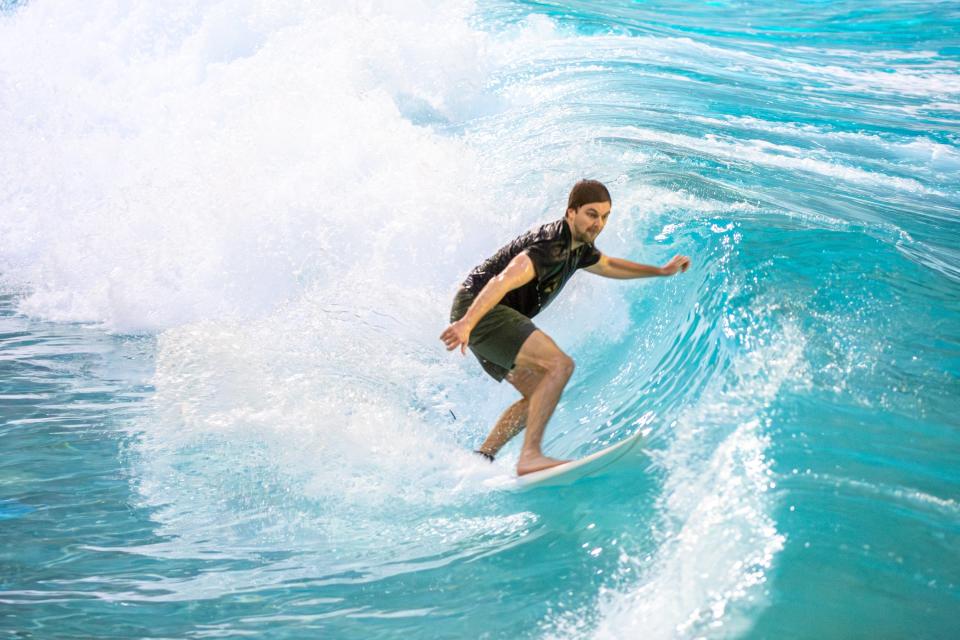
The one turn I had been attempting in Hour 1 became slightly easier. The interval with which I wished away those 30 pounds became larger.
Two 16-year-olds, Ethan and Ayden, told me they were hyped on the setup. One had been to the American Dream once before; it was the other’s first time. Ethan told me that his parents had dropped them off and that Ayden’s parents would pick them up once the clock struck midnight and the waves were turned off. He also told me that it was a two-hour drive, each way, from their Long Island neighborhood to get here. “I’m getting my license in two weeks,” Ethan told me. That would make the process less painful on their parents.
Here, finally, seemed like two strong candidates for the time-honored art of loitering. They told me they’d been hanging around the mall for a while before they surfed. What had they gotten up to, I asked.
“It’sugar,” said Ayden, matter-of-factly.
I wondered if I was missing some kind of slang. No, he was talking about a candy store—the world’s largest non-manufacturer candy store, to be exact. It was next door to the water park. They hadn’t wandered far.
It’s tempting, of course, to stand on the hunched shoulders of Didion and Wolfe, the two patron saints of disdain, to blast this thing. But I felt so much more conflicted about it.
Because yes: The artifice was extreme, the wave was mediocre, and the whole thing was aggressively unnatural, near, and perhaps well beyond, the point of perversion.
And yet: Despite the surfeit of Shreks, despite its spot in the mall, despite seeming like the fakest fucking thing imaginable for an activity obsessed with authenticity, there was actually something somewhat legit in the root of the experience. As anyone who surfs will tell you, the surf anywhere almost always sucks. The wind is always wrong, or the size is too big or too small, or the tide is too high or too low, or there are too many people in the water, or none of those things are wrong but you just aren’t surfing that well that day and it’s easier to blame the conditions. So, yeah, the surf kind of sucked, which made it seem realer and certainly more democratic—more so, at least, than any of the perfection Kelly Slater cooked up.
Did I have fun? Yeah, I guess so. Did I get better at surfing? Maybe. Describing it as memorable seems a bit saccharine, but it’s not wrong.
The one thing I couldn’t shake was the feeling that it was, in spite of the endless stream of action, sort of boring. Surfing the same wave over and over again—there was, in a way, too much of a good thing. The most profound way in which it differed from ocean surfing, it seemed to me, was actually that there was so little downtime.
Warshaw, former professional surfer, former editor of Surfer—and, I should add, wave pool hater—thought that that was the heart of the insult.
“Surfing is really unique. To be a hardcore surfer, what you’re really trying to do is set up your life where you can figure out tide, winds, swell, and further add in ‘What’s my schedule, what’s my work, what responsibilities,’ and figure all that shit out so you can just get a few seconds’ worth of surf,” he said. “It’s fascinating. And addictive, and worth spending decades of your life on.
“When you’re just handing over a credit card and showing up at the right time with the other 12 people who are in your group and getting your 25 waves … it’s just a different sport. And it almost ought to have a different name,” he added. “The fact is that surfing is really, really difficult because the conditions are literally, constantly, always, forever changing as you’re doing it. That’s a thing in its favor. The whole idea that if you punch out repeat waves, that you get better so much faster … who cares about that? Put in the time.”
All process, all downtime, all frustration, blessed little action or transcendence. The time you actually spend standing on the board riding a wave during a surf session—during a surf career, even—is so slim it barely registers on the pie chart of surfing. It is, in essence, a massive time waster. Which is maybe the whole thing.
Finally, Mike got on the mic to tell us our two hours were up. The Green Day song was cut. Everyone toweled off, changed back into land clothes, and scattered.
I wanted to get one more look at the mall in all its cavernous enormity, its empty corridors and vacant storefronts (more than 80 percent leased!), perhaps even glimpse its infamous escalator to nowhere.
I walked alongside Lucas, the wave pool employee, and asked him about the space. He said the mall was so big it always felt empty no matter if there were people there or not. There was a luxury wing that might be worth ogling, he thought, though it was probably closed by now. It was half past midnight. Lucas had to unlock a door to allow the escalator to disgorge us into the parking lot.
My head was still swimming a bit, trying to make sense of the experience. The whole place, I said, seemed a little fucked up. “Yes, bro, this place is fucked up,” he said. “We’ve already had two active shooters.” I looked it up later and found reports about only one shooter. The other incident had been an active bomb threat.
That weekend, some swell popped up on the buoys at Rockaway Beach in Queens. I called the friend who had broken his face at the pool, and we made a plan to drive out and surf. The size looked good enough, even if the period was a little short, and the wind direction seemed favorable.
This was not pure predigital ritual. We checked Surfline, the surf forecasting website with high-resolution webcams and reports that simplify it so far as to color-code the quality. Green equals good, and it was green, so we packed up and rode out.
But then something terrible and familiar happened. We got out there and it was bad. The wind had gone sideshore, putting a chattering texture on the waves. The size was much smaller than the buoys had indicated. Maybe the direction was wrong or the sand was disturbed, owing to the beach renourishment campaign the Army Corps of Engineers was in the midst of completing.
Meanwhile, the waves were, objectively speaking, about the same size and quality as the Dream, but even less quantity. It was at least 40 degrees colder. The wind was barbed.
We stood on the boardwalk and scowled. We got back into the car and drove to a second spot, further up the Rockaways. We stood on the boardwalk and scowled. We got back in the car and checked a third jetty: scowled there too. We got in the car and drove to Long Beach, and repeated the exercise at three separate spots there.
In the end, we didn’t even paddle out. I don’t remember what we talked about, other than the various ways the surf sucked, using a rich, made-up, only semimeaningful vocabulary. We did not progress, we did not self-actualize, we did not get better. We wasted a ton of time.
All told, definitionally forgettable. But, after the pool, it felt sort of virtuous.

